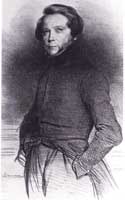
Portrait, by Deveria
David d'Angers

|
Portrait, by Deveria |
| Chronologie | |
| 1788 March 12 | Born at Angers |
| 1793 | Follows his father as a volunteer in the Republican army, against Vendeens |
| 1800-1804 | Apprenticeship with his father, carpenter and ebeniste |
| 1807 | Goes to Paris (atelier Roland after 1809). 2e prix in 1810 for Othryades |
| 1811 | 1e Prix de Rome for Epaminondas, a bas-relief |
| 1811-1815 | in Rome at the Villa Medicis. Romance with Cecilia Odescalchi (d. 1814) |
| 1816 | Travel to London where he meets Flaxman (who confuses him with the painter David) Refuses a commission commemorating Waterloo. Receives commission for Condé, for the Pont Louis XVI in Paris |
| 1825 | Triumphal inauguration of Bonchamps at Saint-Florent-le-Vieil. This work is discussed in the Insurrection of the Vendée |
| 1826 | Named professor at l'Ecole des Beaux Arts in Paris |
| 1830 | Commission for the pediment (fronton) of the Pantheon. Completes the colossal medallion of Rouget de l'Isle |
| 1831 | Marriage to Emilie Maillocheau, grand-daughter of Larevellière-Lépaux |
| 1834 | Second trip to Germany. Defeat in elections in Anjou |
| 1837 | Defeat in elections in Anjou |
| 1839 | Opening of the galérie David at the Museum of Angers |
| 1840 | Unveiling of Gutenberg in Strasburg |
| 1843 | Commission from Comte de Quatrebarbes of a statue of Roi René for Angers (to be erected in 1853) |
| 1847 | Refusal to sculpt the tomb of Napoleon in Invalides |
| 1848 | Participation in the Campagne des Banquets, February Revolution In March, refuses the post of Directeur des musées. Becomes maire of 11e arrondissement in Paris. Is elected député from Anjou to the Constituante. Writes to Victor Pavie " Depuis la Révolution, je n'ai pas remis le pied dans mon atelier. Avant d'être artiste, il faut être citoyen. Voilà ma devise." |
| 1849 | Not re-elected from Anjou. His last entry in the Salon is a bust of Saint-Just |
| 1851 | After the coup d'Etat of Louis-Napoleon, is arrested and is exiled to Brussels, then Greece, accompanied by his daughter Hélène. |
| 1853 | Returns to France where he works in Nice on the statue of général Drouot |
| 1855 | Last visit to Angers |
| 1856 January 6 | Death in Paris. |
David d'Angers studied art in Paris and Rome, and absorbed the lessons of antiquity. His early work, especially, renders Greek classical history in a neo-classical style that some describe as cold and distant. However, the sculptor's larger aim was
...always to highlight the noble side and moral truth of the subject matter.... I have marble and bronze to render genius, virtue, and heroic courage.He became known for his portraits of great men and women, many of whom he met in the political and artistic circles of Paris and Europe. His goal of immortalizing history led him sometimes to depict his subjects in realistic and contemporary dress. His desire to express majestic and powerful ideas led him to dramatic compositions that brings his style closer to a romantic sensibility. In the course of his astonishingly prolific career, he produced over 50 full-size statues, 150 busts, and over 500 portrait medallions of the era's major literary, political, and artistic figures.
| Major works | |||
 |
 |
||
| Pediment of the Pantheon, 1830-37 Read more |
King René of Anjou Read more |
||
This page was meant to be viewed in frames. |
 Return to Return toAmelia Carr's Home Page |